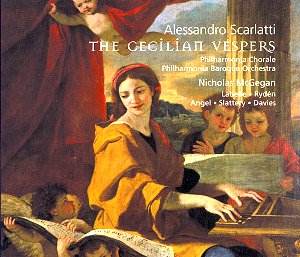Though we have assimilated
many of the performance practices of
previous eras, we still tend to cling
to perceptions based on the 19th
century concept of the artist; preconceptions
which may have little place in music
of the baroque era. The idea of a work
of art, a complete-in-itself masterwork
is one of them. It can be difficult
for us to apprehend the copious quantities
of music written by baroque composers
and we focus on ways to assemble these
disparate elements into what we perceive
as proper complete works. As a result,
we tend to fix on events which allow
us to bring coherence to what we see
as a chaotic oeuvre. These events might
be a particular occasion (the reconstruction
of a service for instance) or a publication;
baroque composers published assemblages
of pieces with the intention that performers
might cherry-pick from them and would
be a little surprised at our tendency
to routinely perform all the pieces
together as a complete entity.
This effect has now
hit Alessandro Scarlatti; recent scholarship
has enabled Nicholas McGegan and his
Philharmonia Baroque Ensemble to make
the first complete recording of Scarlatti’s
St. Cecilian Vespers. Scarlatti wrote
a number of works for the feast of St.
Cecilia, including a Mass, various antiphons
and hymns and this setting of the vespers
service. The vespers service attracted
many baroque composers, but generally
services were assembled from a variety
of musical sources; during the baroque
period there was little concept of a
coherent vespers service written by
a single composer in the same way that
a mass would be. Remarkably, Scarlatti
produced this complete vespers service,
for Cardinal Acquaviva and his newly
consecrated Church of St. Cecilia in
Trastevere, Rome. We know that music
by Scarlatti was performed there in
1720 and parts of the St Cecilian Vespers
were performed in November 1721. But
we don’t really know whether the entire
service was performed in one go, or
whether it was simply mined as a source
book.
Whatever the truth,
we should be grateful to McGegan for
providing us with the opportunity to
hear so much magnificent music; even
if the circumstances might smack more
of 19th century Romanticism
than a genuine baroque event.
Scarlatti specified
the Gregorian antiphons which would
introduce the psalm settings and provided
concerted versions of the antiphons
for performance after the psalm settings.
Here, another element of Romanticism
might be detected. McGegan and his forces
perform the Gregorian chant versions
of the antiphons in pure, unadulterated,
unaccompanied chant (and very good they
sound too). This provides a wonderfully
Romantic contrast with Scarlatti’s highly
developed music. But in his recording
of Vivaldi’s music for vespers on Opus
111, Rinaldo Alessandrini performs antiphons
based on the 18th century
practice, using on a set of parts printed
in Rome during the 18th century;
these use accompanied solo voices and
the chant is ‘corrected’ to form satisfying
verses and recitative. So it would seem
unlikely that Scarlatti ever heard his
vespers performed with pure Gregorian
chant antiphons.
So, having fought our
way through this thicket of speculation
and reconstruction, what of the music.
McGegan and his orchestra
and chorus are in fine form, delivering
superbly crisp performances. McGegan
favours quite brisk tempos and his orchestra
and chorus make light of this, delivering
sparkling performances. The first psalm
setting, Dixit Dominus, uses
all 5 soloists; Scarlatti often using
them in a manner akin to the concertino
group in a concerto grosso, rather than
giving them extended solos. He writes
vocal lines which are often highly decorated
and it is here that the performers rather
fall down.
All five soloists are
distinguished artists with a good pedigree
in period performance. But in Scarlatti’s
elaborate vocal lines they sing the
more complex passages in an unsatisfactorily
laboured manner with the passage-work
sounding, at best, smudged. This only
happens in some passages (presumably
the more difficult ones) at other times
all contribute moments of great beauty.
Quite who is to blame I am not sure.
The singers do sound as if they are
recorded rather closely, and this is
a live recording. I am sure that someone
present at the performance, with the
benefit of the acoustic of the First
Congregational Church, Berkeley, would
have had a rather happier experience.
Also, I did wonder about some of McGegan’s
tempi; whether he should have eased
up a little and allowed the soloists
more leeway.
In the Laudate Pueri
just one soloists is featured, soprano
Dominque Labelle, and she seems to be,
on the whole, more comfortable; her
winning manner of performance, allows
you to forget the imperfections. For
the 3rd psalm, Laetatus
sum, Scarlatti returns to the same
concerted use of soloists has Dixit
Dominus.
On disc 2 the Nisi
Dominus is set for chorus and orchestra
only, as is the Magnificat; both
of these are entirely delightful experiences.
The hymn, Jesu corona returns
to using all 5 soloists. The disc is
completed by performances of another
Nisi Dominus setting with solos
for soprano Susanne Ryden and counter-tenor
Ryland Angel, a Salve Regina
with solos for Soprano Dominique Labelle.
And the disc concludes with a setting
of the Gradual for St. Cecilia’s Day,
Audi, fili.
This is a first recording
of this lovely music and on the whole,
I will look forward to returning to
it. But I know that the imperfections
in the vocal delivery will annoy me
on repeated listening, others may be
more tolerant than me. What the recording
did do, though, is whet my appetite
for more of Scarlatti’s sacred music;
how about a recording of some of the
plums without the conceit of a service
reconstruction.
Robert Hugill
see also
review by Paul Shoemaker







